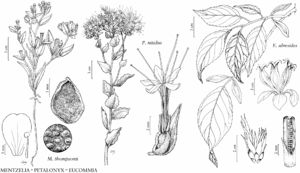Petalonyx
Pl. Nov. Thurb., 319. 1854.
| Taxon | Illustrator ⠉ | |
|---|---|---|
 | Petalonyx nitidus Eucommia ulmoides Mentzelia thompsonii | Linny Heagy Yevonn Wilson-Ramsey Linny Heagy |
Subshrubs or shrubs; trichomes (1) pointed with surfaces ± smooth, notched, or antrorsely barbed, and (2) retrorsely barbed along shaft and at apex. Stems erect or spreading. Leaves cauline; petiole present or absent; blade ovate, elliptic, lanceolate, or falcate, unlobed, margins dentate, serrate, crenate, or entire. Inflorescences racemes or panicles; peduncle inconspicuous. Pedicels not elongating in fruit. Flowers: hypanthium adnate to ovary proximally, free distally; perianth whorls differentiated; sepals green, connate basally, lanceolate, shorter than petals; petals white, distinct or connate, spatulate or obovate, erect proximally, spreading to divaricate distally (corolla salverform or appearing so), glabrous except hairy abaxially on midribs; nectary distal on ovary; stamens 5, exserted, filaments monomorphic, filiform, longer than anthers; anthers without distal connective extension; staminodes absent [present]; pistil pseudomonomerous, placenta subapical; stigma lingulate, 2-lobed, papillate. Fruits cypselae, ±clavate, straight; sepals persistent. Seeds 1, ovoid. x = 23.
Distribution
w United States, n Mexico
Discussion
Species 5 (4 in the flora).
Petalonyx belongs to subfam. Gronovioideae, which is characterized by relatively small flowers that have five stamens, one ovule, and indehiscent fruits. Petalonyx is most closely related to a clade that consists of Cevallia, Fuertesia Urban, and Gronovia Linnaeus (L. Hufford et al. 2003). Petalonyx crenatus A. Gray ex S. Watson, from Coahuila, Mexico, is the only species of the genus known only from outside the flora area; it can be distinguished from the species treated here by having two anther-bearing stamens and three shorter staminodes, rather than having five anther-bearing stamens.
Selected References
Key
| 1 | Leaf blades usually elliptic, sometimes falcate, to 5 mm wide, margins entire; petal claws distinct; stamens exserted distally (not laterally between petal claws). | Petalonyx linearis |
| 1 | Leaf blades ovate, or if elliptic then to 15–30 mm wide, margins usually serrate, dentate, or crenate, sometimes entire; petal claws postgenitally distally coherent; stamens exserted laterally through slits between petal claws. | > 2 |
| 2 | Petioles absent; leaf blades with marked size dimorphism, much larger on main stems than on fertile branches; petals to 6.5 mm. | Petalonyx thurberi |
| 2 | Petioles 0.5–4 mm; leaf blades without marked size dimorphism; petals 6–15 mm. | > 3 |
| 3 | Inflorescences 10–30-flowered; petals 6–11 mm; branches of current season 11–37 cm. | Petalonyx nitidus |
| 3 | Inflorescences 35–65-flowered; petals 10–15 mm; branches of current season to 13 cm. | Petalonyx parryi |
"not elongating" is not a number.